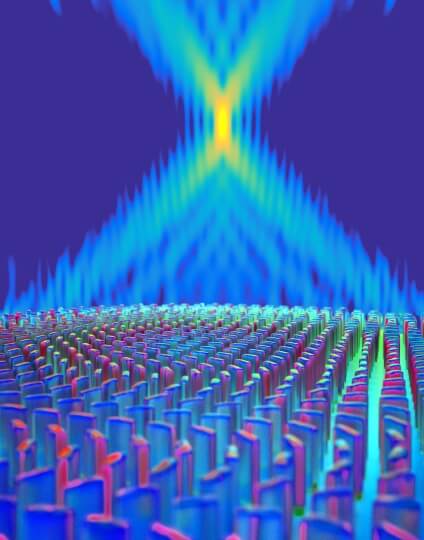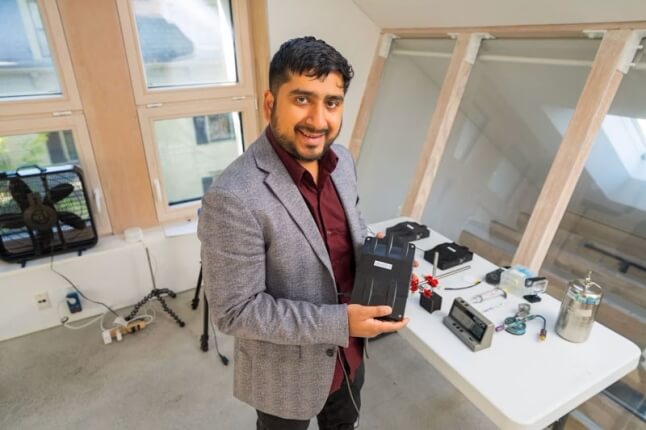News
An illustration of the ultra-thin planar lens. The lens consists of titanium dioxide nanofins on a glass substrate. The lens focuses an incident light to a spot smaller than the wavelength this tight focusing enables subwavelength resolution imaging. (Image courtesy of Peter Allen/Harvard SEAS)
Download ImageA startup company founded by applied physicists at the Harvard John A. Paulson School of Engineering and Applied Sciences (SEAS) intends to transform consumer electronics by introducing a powerful technology for imaging and illumination that could replace conventional lenses with an ultrathin, flat optical microchip.
Harvard’s Office of Technology Development (OTD), which cultivates the University’s industrial research collaborations and oversees technology commercialization, has granted Boston-based Metalenz, Inc. an exclusive, worldwide license to a portfolio of innovations in flat optics developed in the Harvard lab of Federico Capasso. Metalenz made its plans public today and announced $10 million in investment from Intel Capital, 3M Ventures, Applied Ventures, and TDK Ventures, among others. The funding and semiconductor manufacturing expertise will enable the further engineering of metalenses toward large-scale fabrication for consumer, healthcare, and automotive applications, using the established technology of semiconductor chip manufacturing.
The metalens technology exploits the interactions of light and matter at the nanometer scale to achieve unprecedented control of the behavior of light. Conventional optics refract, reflect, and polarize light as it passes through the bulk of a material, while the Capasso Lab’s innovations use minuscule patterns and structures at the surface to redirect light at will. The resulting technology is a wafer-thin chip not only capable of disrupting the field of digital imaging, but also poised to enable new types of ultracompact devices for 3D sensing, augmented reality, virtual reality, and more.
“It has been rewarding to see Metalenz successfully emerge as a startup following a decade of research in my group that has ranged from generalizing the centuries-old Snell’s law of refractive optics to the realization of flat lenses that outperform conventional ones,” said Capasso, who is the Robert L. Wallace Professor of Applied Physics and Vinton Hayes Senior Research Fellow in Electrical Engineering at Harvard SEAS. Capasso is a co-founder of Metalenz and a board member of the company.
Over the years, dozens of researchers in Capasso’s lab have contributed to the innovations. In leaps and bounds, with a vision of what might be possible, they developed a richer understanding of the fundamental physics, demonstrated new methods of fabrication, incorporated advanced materials, and computationally designed metasurface architectures that produce the desired optical effects across broadband wavelengths.
Their work was supported largely by federal funding from the U.S. Air Force Office of Scientific Research, the Defense Advanced Research Projects Agency, and the National Science Foundation (including via Harvard’s Center for Nanoscale Systems), as well as by OTD’s Physical Sciences and Engineering Accelerator as the technology approached commercial readiness.
“The metalens platform has the potential to drive a revolution in imaging and sensing, from the ubiquitous cameras in cell phones, cars, and self-driving vehicles to AR/VR, and in the future to widespread use in drones and CubeSats,” said Capasso. “I am grateful to Harvard OTD for encouraging and supporting, all along, the creation of Metalenz.”
“The Capasso Lab has created a robust and exciting technology platform that really challenges the status quo in optical physics,” said Alan Gordon, director of business development in OTD. “These researchers have had the vision and conviction to direct their ingenuity toward overcoming a major challenge that impacts numerous industries. The Metalenz team carries forward that technical expertise and entrepreneurial instinct.”
Robert Devlin, PhD ’17, is co-founder and CEO of Metalenz. Pawel Latawiec, SM ’16, PhD ’18, is the company’s director of design and computation. Both are SEAS alumni.
Topics: Applied Physics, Industry
Cutting-edge science delivered direct to your inbox.
Join the Harvard SEAS mailing list.
Scientist Profiles
Federico Capasso
Robert L. Wallace Professor of Applied Physics and Vinton Hayes Senior Research Fellow in Electrical Engineering
Press Contact
Caroline Perry




